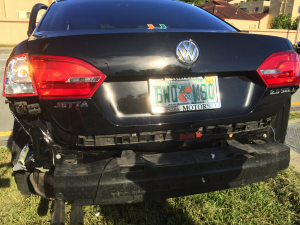Posted April 30, 2016
By BREANA ROSS
University of Miami sophomore Chantel Batista was driving to campus one afternoon on U.S. 1, when a car bolted in front of her unexpectedly, causing her to have to slam on her brakes and catch her breath.
“It just taught me not to trust other drivers around me,” Batista said. This is the norm for many drivers in Miami.
From the wheel of a car, Miami’s beautiful scenery turns into a not-so-attractive, potentially dangerous scene. According to the Florida Highway Patrol, Miami-Dade leads Florida’s three major counties in car accidents; with 17,497 crashes this year alone and 2,252 crashes just this month.
“I think the Miami area is a challenging area for commuting and driving,” said University of Miami Crime Prevention Specialist John Gulla. “There are a lot of people in the area. There’s a lot of traffic and I think it’s not necessarily indicative of other areas of the country where things may be a little bit more easily navigated for drivers.”
Although cities like New York and Los Angeles are significantly larger in area and population, Miami has a comparable number of crashes. Miami is a relatively small city, in comparison, with an overpopulation of cars on the road. Within Miami’s 1.54 billion square feet, there are 1.98 million registered vehicles.
“I have lived in places like Washington, D.C., and New York and even larger cities where there’s still a lot of traffic, but Miami seems to have a lot more commuters than those areas so there’s a lot of competition on the roads, which leads to a lot of aggressive driving as well,” Gulla said.
With so many cars on the road, there is little room for error without consequence. Miami drivers tend to disregard the basics of driving.

The bumper of a University of Miami student’s car hangs after an accident (Photo courtesy of Sidney Sterling).
“A turn signal doesn’t mean a turn and lack of a turn signal doesn’t mean they’re not turning,” said David Steinberg, a University of Miami Communication Studies professor. “People do not signal. If they are signaling, it’s probably random and it doesn’t mean they’re turning.”
Miami-Dade County Police Officer David Torres said that failure to use a signal and improper lane changes are two main causes of accidents in Miami. Speeding is another accident cause and common ticketing offense.
“On average I give around seven to eight speeding tickets a day,” Torres said.
According to freshman commuter Isabella Cendan, the tendencies for speeding, failure to use a signal and improper lane changes have to do with the attitudes of local drivers.
“I grew up in Miami, so a lot of people that I know here put themselves first,” Cendan said. “It’s always like they need to be somewhere so they’ll get there no matter what.…They won’t use their blinkers or they won’t wait the full time at a stop sign just to get somewhere faster.”
In such a diverse city, many Miami drivers come from different countries, which also contributes to confusion on the roads.
“I feel like the bad driving can be attributed to more of an international scene,” said Kemble Mountcastle, a sophomore from Virginia. “There’s obviously a big Spanish scene and Latin American scene down here. Maybe, if they moved recently from their home county, the driving rules are different.”
Although the overload of cars and diverse culture of drivers make driving in Miami unique from other large cities, there is one problem that remains consistent in Miami and nationwide; distracted driving.
Sgt. Alejandro Escobar reported that Coral Gables police officers gave out 1,338 careless driving citations last year.

A driver holds a phone while one hand remains on the steering wheel. (Photo courtesy of U.S. Marine Corps).
Using a phone or texting while driving is the main form of distracted driving, but some Miami drivers do not stop there.
“I’ve been in traffic and I’ve seen a guy shave while he’s driving,” said Association of Commuter Students member Antonella Valdivia. “Actually shaving in traffic with shaving cream, looking in the mirror.”
The problem of distracted driving, among other offenses, also carries over to University of Miami’s campus in Coral Gables. Gulla said University of Miami police officers catch many students texting while driving or texting while crossing streets.
“You have this convergence of distracted activities, which unfortunately leads to a significant rise in safety issues, especially for our population,” Gulla said.
Speeding, failure to stop at stop signs and failure to give pedestrians the right of way are other problems University of Miami police see from students.
“Our focus is not on ticketing,” Gulla said. “We don’t gain anything by the ticket in that way. What we’re gaining is we’re trying to make sure that people are understanding of how much commuter traffic we have on campus.”
In an effort to educate and inform students on campus about traffic safety, University of Miami Police Department works with the Florida Department of Transportation on the “Put it Down Campaign” to stop texting and driving and the “Drive Safe” campaign to stop aggressive driving.
The UM Police has also participated in multi-agency law enforcement, teaming up with Coral Gables Police Officers and South Miami Officers to pass out information to commuters on roads surrounding campus. These events will b

